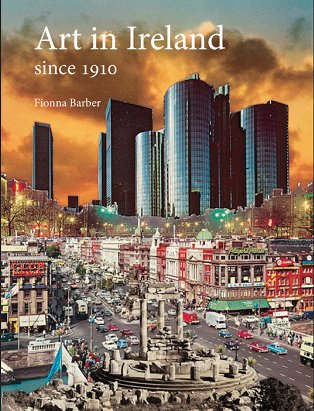Fionna Barber: Art in Ireland since 1910

Launch Wednesday 20 March 6:30 – 8pm by Declan McGonagle, Director, NCAD
‘Art in Ireland has traditionally fretted in the shadow of a powerful literary tradition but Fionna Barber provides the first major overview of how evolving forms of art practice shaped twentieth-century Irish culture. Ranging from the Celtic Twilight to the Celtic Tiger, Art in Ireland brings a new visual sophistication to bear on “Romantic Ireland”, social realism, modernism, as well as gender, Northern Ireland, and the globalization of Irish art. This innovative work recasts not only Irish art history but also our understanding of Irish art in a wider international frame.’ – Luke Gibbons, National University of Ireland (Maynooth)
‘Anti-colonial struggle, civil war and postcolonial violence; nationalism, isolationism and the new Europe of the Celtic Tiger; flirtations with fascism and Third World revolution; the revival of an ancient pre-Christian spirit in a political culture framed by institutional religions; a passion for land and peasantry and a history of exile. Ireland has lived modernity more deeply and more passionately than perhaps any other European nation. The country’s contributions since 1910 to music, drama and literature are unquestionable. Fionna Barber’s Art in Ireland marks out the parallel territory of the visual arts as they traversed these contradictory histories. With a cunning eye for precise detail, Barber not only writes the story of art in Ireland, North and South: she opens up the contested and unfinished labour of formulating country, time and identity in Irish art.’
– Sean Cubitt, Goldsmiths, University of London
Art in Ireland since 1910 is the first book to examine Irish art from the early twentieth century to the present day. In this highly illustrated volume Fionna Barber looks at the work of a wide range of artists from Yeats and le Brocquy to Cross and Doherty, many of whom are unfamiliar to audiences outside Ireland. She also casts new light on Francis Bacon and other figures central to British art, assessing the significance of their Irishness to an understanding of their work.
From the rugged peasantry of the Gaelic Revival to an increasing diversification of art practice towards the end of the century, Art in Ireland since 1910 tracks the work of artists that emerged and developed within a context of a range of very different social and political forces: not just the conflict in the North, but the emergence of feminism and migration as two of the factors that contributed to the unravelling of entrenched concepts of Irish identity. Barber looks at the theme of diaspora in the work of Irish artists working in Britain during and after the 1950s, investigating issues similar to those facing artists from other former British colonies, from India to the Caribbean. She chronicles a period that culminated with art practice and the sense of Ireland as a nation that would have been unrecognizable to its people a hundred years before.
Richly illustrated, Art in Ireland since 1910 is essential reading for anyone interested in modern art, Irish Studies and the history of Ireland in general.
Fionna Barber is Principal Lecturer for Contextual Studies in the Manchester School of Art at Manchester Metropolitan University. She has contributed to many publications on art history and Irish Studies.
56 - 58 Dawson Street
Dublin 2
